Central panel of The Garden of Earthly Delights (c. 14901510) by Hieronymus Bosch.
(Photo:Public domainvia Wikipedia)This post may contain affiliate links.
If you make a purchase, My Modern Met may earn an affiliate commission.

Central panel of “The Garden of Earthly Delights” (c. 1490–1510) by Hieronymus Bosch. (Photo:Public domainvia Wikipedia)This post may contain affiliate links. If you make a purchase, My Modern Met may earn an affiliate commission. Please readour disclosurefor more info.
hey readour disclosurefor more info.
And during this time, he was a leader in Early Netherlandish painting.
Who Was Hieronymus Bosch?
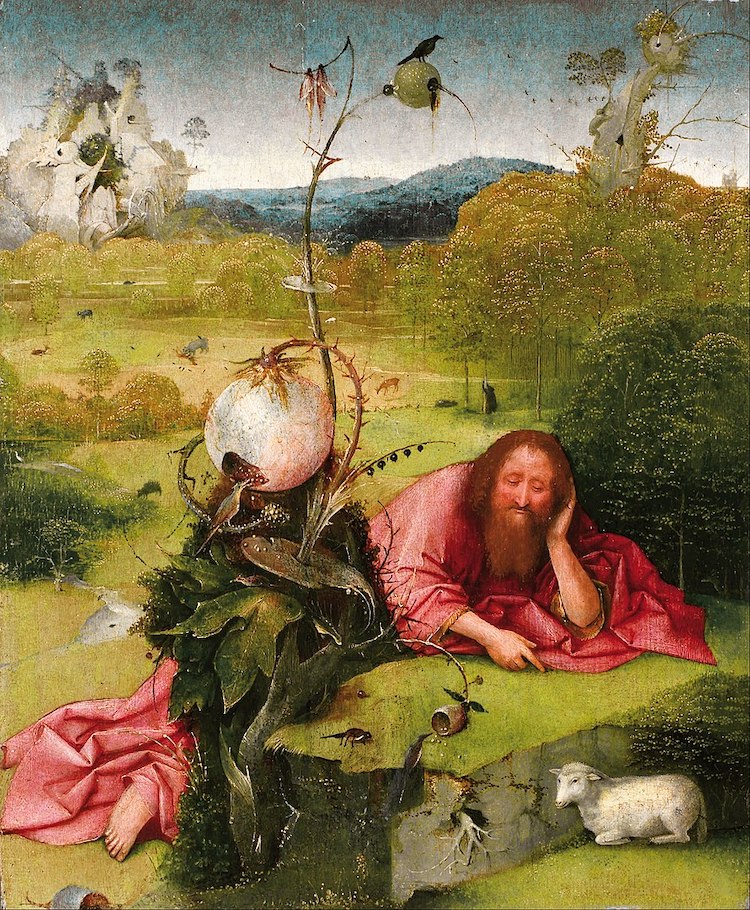
“St. John the Baptist in the Wilderness” (c. 1489) by Hieronymus Bosch (Photo:Public domainvia Wikipedia)
He was bornJheronimus van Akenin the Dutch town ofs-Hertogenbosch, which was often called Den Bosch.
This is where his famous last name comes from.
It’s unclear when Bosch was born, but scholars believe it was around 1450.
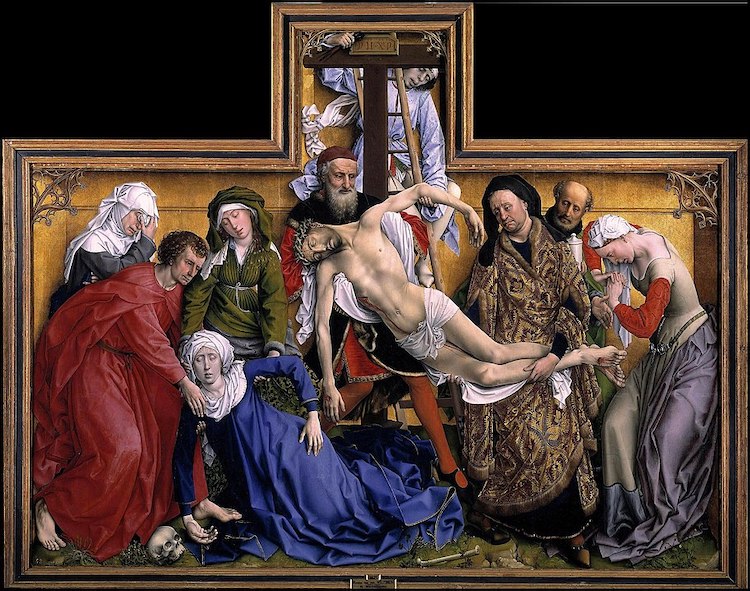
“The Descent from the Cross” (c. 1435) by Rogier van der Weyden (Photo:Public domainvia Wikimedia Commons)
He was first mentioned in city records in 1474 when he was named along with his siblings.
His birth year is typically estimated based on a self-portrait he drew in 1516, the year he died.
In that drawing, he appears around 60 years old.
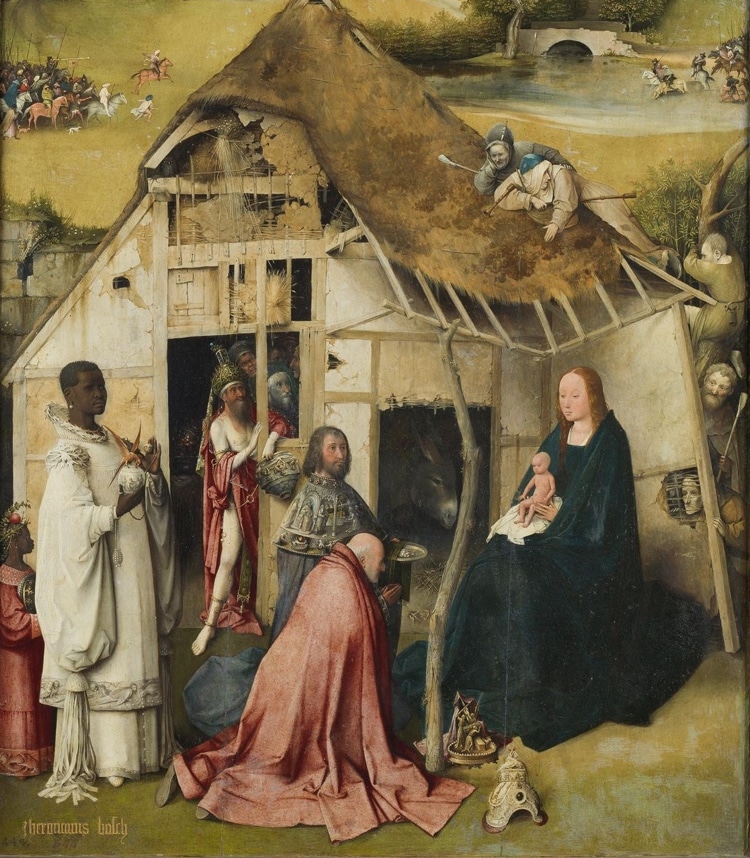
Detail of central panel of “Adoration of the Magi” (c. 1485–1500) by Hieronymus Bosch (Photo:Public domainvia Wikipedia
We do know that he was born into a family of artists.
His grandfather Jan van Aken and father Antonius van Aken were both painters.
Often referred to as theNorthern Renaissance, art blossomed under the patronage of the ruling dukes.

“The Crowning with Thorns” (c. 1510) by Hieronymus Bosch. (Photo:Public domainvia Wikipedia)
As the economy of theLow Countriesexploded, money for high-paying commissions poured in.
The use of oil paint allowed these artists to create paintings with rich, layered colors.
Complex iconography, genre scenes, and landscapes were all commonplace.
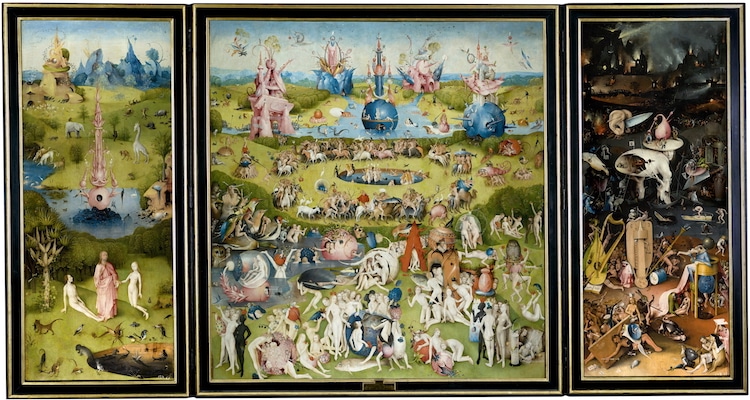
‘The Garden of Earthly Delights” (c. 1490–1510) by Hieronymus Bosch. (Photo:Public domainvia Wikipedia)
But his subject matteror rather how he visually expressed his subject matteris what separates him from the pack.
His work was dominated by hellish scenes filled with demons, fires, and bizarre figures.
He would often incorporate animals into his paintings, taking advantage of their symbolism.
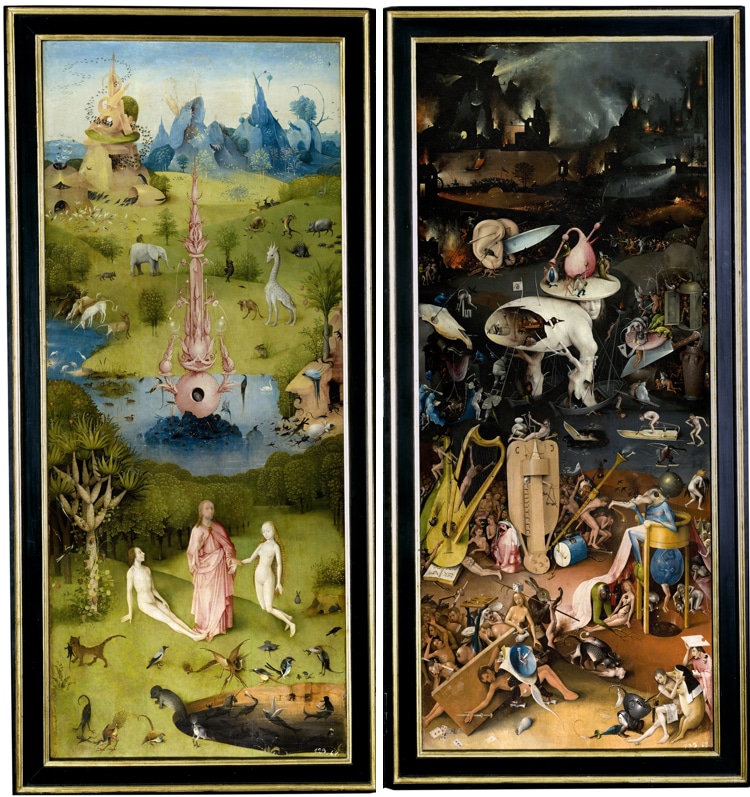
Left and right panels. (Photo:Wikimedia Commons, Public domain)
InThe Garden of Earthly Delights, animals take center stage, often tormenting humans for their misdeeds.
The Crowning with Thorns (c. 1510) by Hieronymus Bosch.
(Photo:Public domainvia Wikipedia)
Fantasy hellscapes dominate his work.

Detail of right panel. (Photo:Public domainvia Wikipedia)
The Last Judgment, Seven Deadly Sins, and temptation are frequent themes one often finds in his paintings.
The devil is a recurring figure.
Here, the scale is enlarged and just a few figures are densely packed together in the foreground.
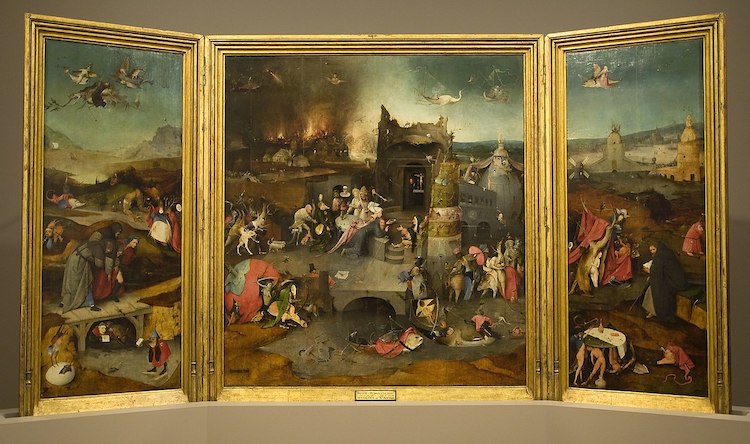
“The Temptation of St. Anthony” (c. 1500) by Hieronymus Bosch (Photo:Public domainvia Wikipedia)
Famous Works of Art
Bosch’s oeuvre has been an interesting mystery for art historians.
Because he rarely signed his paintingsand never dated themputting together a timeline of his art is an evolving puzzle.
Attribution is also an issue.
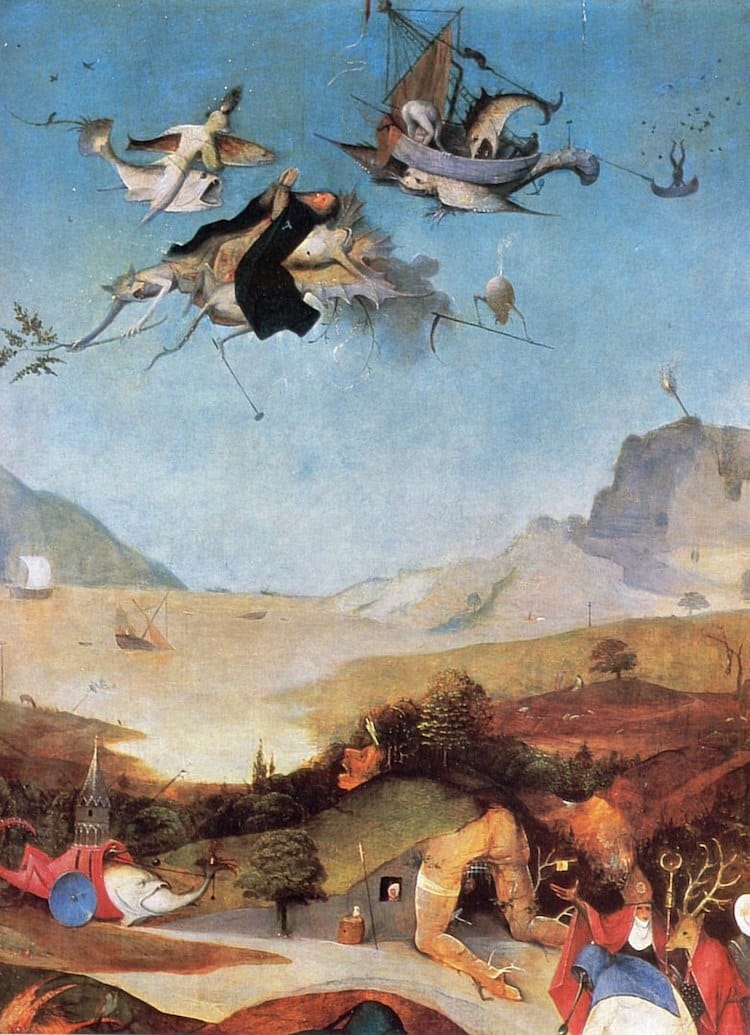
Detail of right panel. (Photo:Public domainvia Wikipedia)
As such, well-executed copies circulated and have often been the subject of debate by scholars.
But even for all these problems, there is no denying Bosch’s impact on the art world.
Let’s look at two of his most famous triptychs to get better insight into his creative mind.
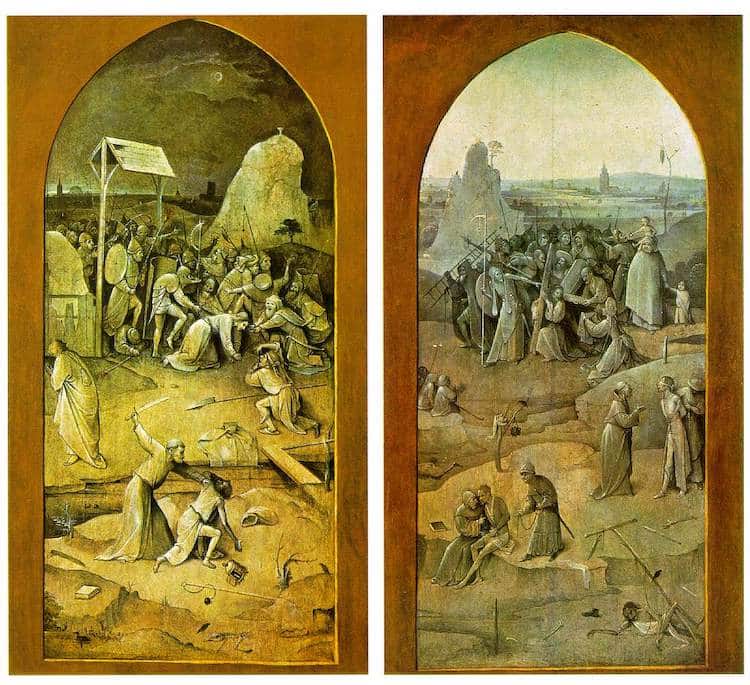
Closed triptych (Photo:Public domainvia Wikipedia)
The Garden of Earthly Delights
The Garden of Earthly Delights (c. 14901510) by Hieronymus Bosch.
Odd, fantastical animals already made their appearance, crawling from a hole in the foreground.
The background is populated by exotic animals, including a monkey riding an elephant and a giraffe.
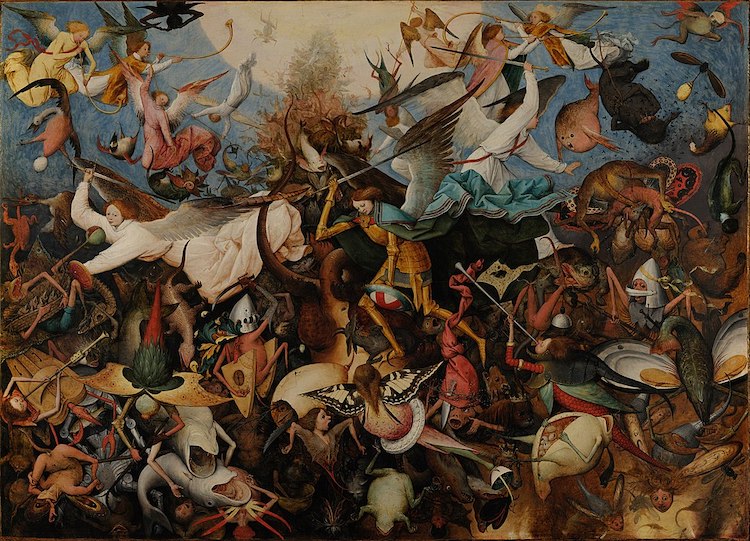
“The Fall of the Rebel Angels” (1562) by Pieter Bruegel. (Photo:Public Domainvia Wikimedia Commons)
Left and right panels.
(Photo:Wikimedia Commons, Public domain)
The center panel is filled with hoards of nude figures.
Some cavort and frolic with animals while others enjoy nibbling on oversize fruit.
This depiction of excess pleasure has been interpreted in many ways.
Detail of right panel.
In this panel, we see cities on fire, demons, and people being tortured by animals.
A central figure of this panel has been dubbed the Tree-Man.
His bloated torso is a broken eggshell supported by tree trunks.
This would have been consistent with morals from the Middle Ages.
Visual depictions of his story were common in Medieval and Renaissance art.
Spending many years in the Egyptian desert as a hermit, devoting himself to prayer.
The devil, angry with his decision, sent numerous temptations to lure him from his spiritual path.
Bosch uses his trademark symbolism and bizarre characters to bring a visual to Anthony’s anguish.
In the central panel, the saint can be seen kneeling in the center.
There are several demonic groups in the panel that include depictions of the devil.
In one instance, the devil is playing the harp, while in another it’s riding a chicken.
The right panel shows the flight and fall of St. Anthony.
Here, we see the saint being carried through the sky by a pack of demons.
Down below, a weary St. Anthony is helped by two monks and a layman.
The layman has traditionally been identified as Bosch himself.
In the left panel, we see Bosch’s version ofTheContemplation of St. Anthony.
The saint is seen in contemplation at the center.
The exterior panels of the triptych, only seen when it was shut, are also quite interesting.
As Bosch often did with these panels, they are painted in grisailleor shades of grey and white.
Bosch’s portrayal of the story was quite popular and spurred numerous copies, many of which still exist.
Bruegel’s depictions ofpeasant lifeoften contained grotesque characters clearly influenced by Bosch’s fantastical paintings.
Much later, in the 20th century, his work would become a favorite among theSurrealists.
Books About Hieronymus Bosch
Want to expand your knowledge about Hieronymus Bosch?
Check out some of these books.
(Making a purchase viaBookshophelps support independent bookstores.)
Frequently Asked Questions
Why is Hieronymus Bosch important?
Bosch is considered an important artist of the Northern Renaissance or Early Netherlandish painting.
How many Bosch paintings are there?
Where isThe Garden of Earthly Delightslocated?
Bosch’s most famous artwork is part of the Prado Museum’s collection.
Located in Madrid, Spain, the museum has housed the artwork since 1939.
Learn About the Pioneering Northern Renaissance Printmaker
Learn the Intriguing (and Sometimes Controversial) History Behind Michelangelos Last Judgment